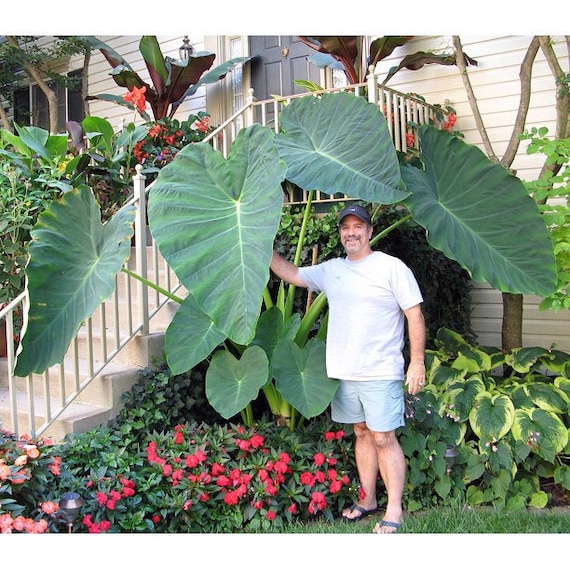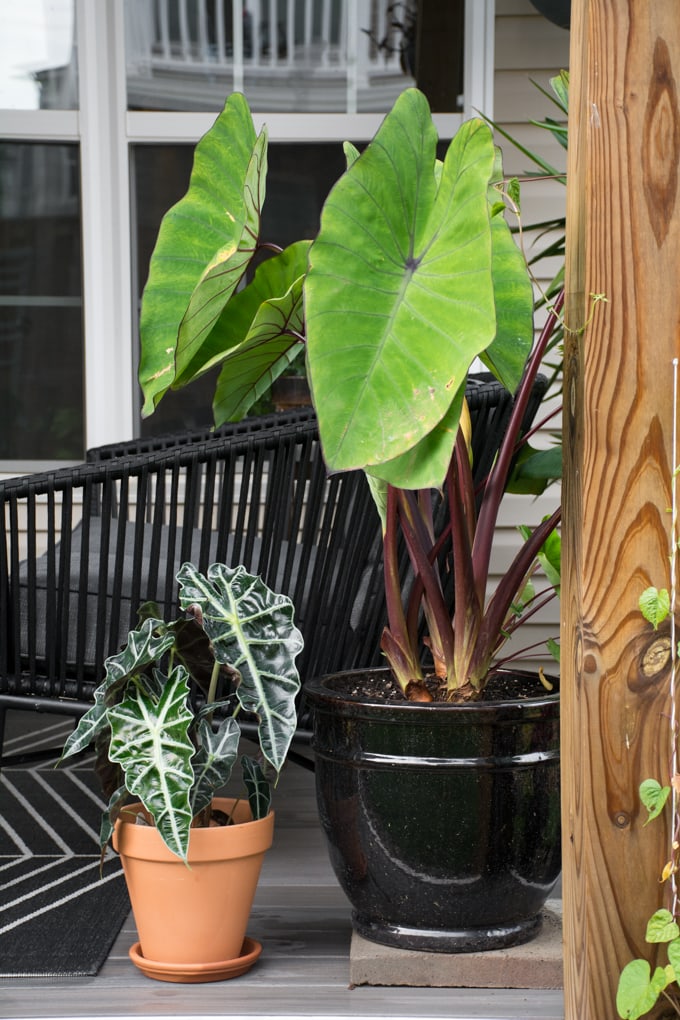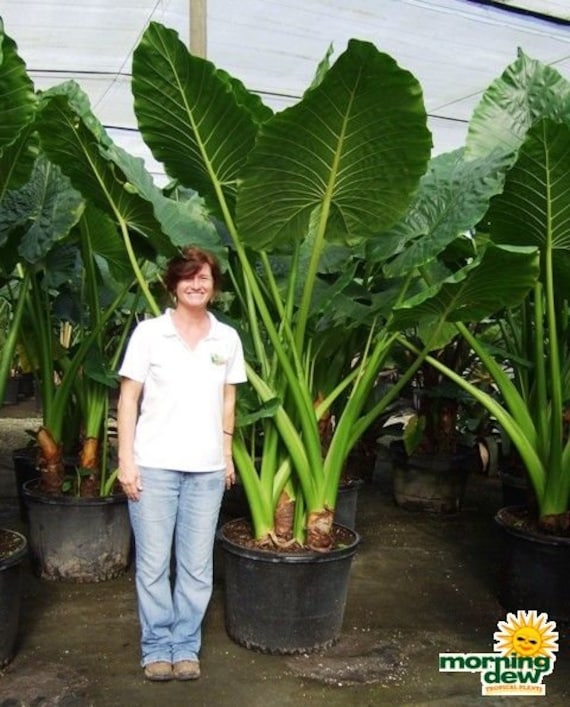If you’re looking for drooping elephant ear plants, keep reading to learn more about these tropical plants with enormous leaves that look like elephant ears. I have provided a comprehensive treatment for limping and drooping of Alocasia or elephant ear plants because I am aware how difficult it is to maintain such big leaves and how they can occasionally begin to wilt. Why does my elephant ears plant seem to be sagging?
Elephant ear plant drooping: Overwatering, underwatering, or wind damage to the plant are the three most frequent causes of elephant ear plant drooping. When leaves get so big that they wilt sideways, elephant ears droop because they need support. I would suggest giving the elephant ear plant enough water, or watering it in a controlled manner, to resolve this problem. Sometimes the answer is to offer assistance.
I was able to list all the causes and solutions for leaves wilting because the issue known as elephant ear leaves drooping is not new and it affects many plants with huge leaves.
The plant is such a phenomenal leafy grower that it need a lot of everything to grow, which is why it grows best in soil near rivers or where there are ponds in tropical climates. Because its leaves are so enormous, we can cultivate it and see for ourselves how it has such extraordinary growth. Let’s now get into the specifics of the solution.
Table of Contents
Why is my elephant ears plant drooping?
Elephant ear plant drooping is most frequently caused by overwatering, underwatering, or being harmed by environmental conditions. They frequently needed a sturdy wooden or metal pole to maintain their straightness; otherwise, the leaves would grow too big, causing the plant to wilt sideways. I advise giving this wilting elephant ear plant enough water or controlled watering to correct the problem. Sometimes simply offering more assistance, issues are automatically fixed.
I understand that when a green leafy plant begins to wilt, it looks horrible, and it disappoints us to see that it isn’t growing the way we want it to. I constantly discover this in my elephant ear plant, but I can fix it by working out the precise answer.
When my plant exhibits any symptoms, such as yellowing or wilting, I most likely work on a remedy. I’ve included 8 causes of elephant ear plant drooping in hopes that they will help you find a remedy. Check them out and good luck!
1. Leaf becoming Heavy
If you gave your elephant ear plant great care, it’s possible that the leaves have grown to such a size that they are beginning to droop because they appear heavy. This is because fertilizers are used, a favorable location and climate, as well as fertile, well-draining soil, enable plants to flourish to their full potential. Sometimes, gardeners like us show the same level of concern for our plants as we do for our kids. Because they receive good care, they grow well. then what?
Use wooden stakes or a rod to position it upright to aid the leaves and support them so they don’t droop or limp as a solution to this issue. It would undoubtedly resolve the problems, allowing your plant to once more develop to greater heights. Elephant ear plants’ broken stems are always caused by larger leaves, however occasionally the wind can also be to blame.
Giving your elephant plant too little fertilizer is another approach to address this. Even so, you should protect your plants from strong winds by obtaining a fence screen or trunk protection.
Elephant ear plants for sale
Purchase on Amazon
Purchase on ETSY
2. Watering Issues
The elephant ear plant’s leaves limp most frequently as a result of improper or excessive watering, which causes the plant to droop. The issue would lead to either dry circumstances or damp soil. I’ve covered both issues below.
Overwatering is a problem where individuals frequently water plants too much, causing the elephant ear plant to feel trapped by the stream of water. This drooping problem is caused by clogged soil, which prevents roots from absorbing nutrients from the soil and restricts the flow of water to other sections of the plants. The foliage will perish quickly if roots are unable to supply water and nutrients to the stem or leaves, before symptoms like drooping, brown patches, yellowing, and rotting cause the plant to slowly lose its life with each passing day. Because of this, figuring out the issue is crucial. Root rot can also be caused by overwatering, which can encourage a fungal infection that would seriously harm your plant and pose a threat to its existence.
You can manage how frequently you water elephant ear plants to solve this issue. recognizing when to water and reducing the amount of pouring you did before reading this post. The general rule is to always inspect the soil before watering and feel the top 2 inches of soil with your finger to check for moisture. Depending on the water, you can feel dry or wet.
3. Underwatering
Our elephant ear plant is drooping because it can easily wilt when given too little or no water. They flourish in moist to wettish soils and frequently need a lot of indirect light to develop. Additionally, in order to create such enormous leaves, they require additional water. If they are unable to obtain this water, the leaves will become thirsty and begin to limp or droop as they continue to wait.
Watering your elephant ear plant whenever it appears dry can solve the issue. The majority of the time, this issue arises on bright days, when they require more water, necessitating more frequent watering.
If the underwatering issue isn’t fixed, it may attract pests that could hinder its growth and it might even perish.
4. Water Quality
Have you heard the joke about the swimming pool where people would refer to the chlorine in the water. Similar to how tap water with salt or fluoride can lower the quality of water you provide to a plant. As a result, the elephant ear plant may droop, or the edges or tips of the leaves may become brown. If you fix the over- and under-watering issue, your elephant ear plant problem may be resolved.
To solve this issue, you can use filtered water, rainwater, or water that has been held in an aluminum jug or left out overnight and then given to the plant the next day because water stored in an open container over time causes the chemicals to break down.
5. Soil Issues
You probably already know that these plants need healthy, rich soil to grow, and that their development may be hampered if such soils are deficient in certain vital elements. Elephant ear plant leaves may droop in low-nutrient soil that has never received supplemental fertilizer. Pouring the proper nutrition that our ear plant needs will help you address the problem.
Amazon has the best nutrient-rich soil for elephant ear plants.
6. More fertilizer Needs
Elephant ear plant leaves need more essential boosters when they grow huge, as this may speed up their growth. They consume a lot, there is no doubt about that, but providing them with fertilizer in the proper manner is also crucial.
The only proper way to fertilize them is to directly pour a solution into the soil, as opposed to spraying fertilizer on their huge leaves. Additionally, avoid overfeeding them since this will also cause issues for our elephant plant. Overfeeding might cause the roots to burn, which would stop the plant’s other sections from getting water. Additionally, they could cause elephant ear leaves to droop.
The ideal fertilizer for elephant ear plants is as follows:
Fertilizer with Slow Release
Link 1: Amazon shopping
Link 2: Buy things on Amazon
7. Nutrients Deficiency
A fertile soil is one that balances the three main nutrients, potassium, nitrogen, and phosphorus. These N-P-K-rich soils have low levels of some potting mix, which hinders plants’ ability to develop normally. Elephant ear plants’ nitrogen deficiency can be resolved by using the slow release fertilizer I indicated above. Elephant ear leaves can droop due to a lack of any of these nutrients or low levels of any of them.
Please read the fertilizer’s instructions. Use it sparingly, and throughout the growing season are the best times to apply this type of fertilizer. It can be given during the summer. I’m hoping it will aid the plant in expanding and solving all of its issues.
| Elephant Ear plant | Alocasia and colocasia |
8. Repotting issue
Sometimes Our elephant ear plant’s roots can become injured during repotting, or the change in position can startle the plant. Not just elephant ears, but any plant may exhibit that behavior. The plant may appear to be sagging, but it will bounce back after you give it water and time.
The roots need time to settle properly and become accustomed to their new environment when they are planted in new soil. Plan to check the weather and temperature in the new site; if it’s colder there, it can take longer for your plant to recover; otherwise, depending on the type of plant, it will recover in 1-3 days.
For every plant, this is only ever a short-term issue. It will eventually recover and sprout all of its leaves again.
9. Improper light
Elephant ear plants frequently have burned leaves when they are grown in direct sunlight. You are aware that a bright area with indirect light is where they like to grow those enormous leaves. Your plant also receives very little light. It also contributes to the problem of overwatering since, in the absence of much light, soil that won’t dry makes the soil moist, which affects the roots and causes drooping in elephant ear plants. Selecting a decent position for your elephant ear plant that has adequate light for the growth of its leaves is the greatest remedy to the droopy problem. indirect light that our plant can receive.
I won’t advise you to put an elephant plant in the south-facing window because these plants are often grown outdoors; nevertheless, if grown indoors, the south-facing window can provide the plant with the necessary light. Your plant will thrive if you simply set it in a good, indirect light source.
| Elephant Ear plant | Alocasia and colocasia |
10. Cold Temperature
Your plant can seem to have a hard time growing in locations with freezing cold climates. Because of the effects of early frost, elephant ear plant leaves can droop. They start to show indicators of an impending blast of ice that could seriously harm your elephant ear plant’s roots and foliage. I’ve noticed that they generally survive, but if your elephant ear plant is having trouble with such intense frost, do the following actions to save it:
Temperature
Elephant ear plants flourish in warm regions with year-round temperatures between 60 and 80 degrees Fahrenheit. Their leaves turn brown, some develop blotches, and the plant may even freeze when the temperature falls below 40 degrees Fahrenheit. The chilly temperature that causes elephant ear leaves to droop can also induce dehydration, inner cell damage, and other symptoms.
You can possibly take them inside and give a warm environment to solve this issue. shutting windows at night and using an electric heater. Once more, you can put it in a suitable spot indoors where the elephant ear plant can receive indirect light.
The method I mentioned just above this one, where I talked about taking out the rhizome and storing it on peat moss so it will not die and can be replanted back in the spring to save the life of our elephant ear plant, can be used to save your plant if it appears to be significantly affected by the cold climate.
| Elephant Ear plant | Alocasia and colocasia |
low humidity
Your elephant ear plant will grow considerably more healthily in an environment with good humidity levels of more than 50%. However, the low humidity means that there isn’t enough moisture for our elephant ear plant to droop. If your plant has trouble growing in a warm atmosphere, I would suggest investing in a humidifier.
11. Pest infestation
Elephant ear plant pest infestation can cause discolouration, dryness, and drooping conditions. Pests like mealybugs, spider mites, and aphids weaken plants by sucking up their sap. These bugs remove all the nutrients stored in the stem or leaf, causing the leaves to become pale and browned. If there are pest problems, elephant ear plants frequently show signs like stains, rips, and holes. To get rid of them, use pesticides whenever possible. Neem oil can be used as a natural remedy. A splash of water can wash off insects like aphids.
12. Diseases
Elephant ear plants are susceptible to both bacterial and fungal infections, both of which have the potential to be quite destructive. diseases that could cause the leaves to droop and wilt include bacterial rot, fungal infection rot, and various forms of root and stem rot.
The majority of the time, once your plant is infected, it cannot be reversed, but having proper soil, keeping it dry, and removing all infected leaves can stop any rot from occurring to your elephant plant.
13. Root bound
If you cultivate elephant ear plants in pots, the roots clinging to the pot may cause the leaves to droop. Elephant ear plants will wilt and droop if the roots have occupied all the available space in the pot and there is now very little soil remaining to supply nutrients to the roots. You may either get a new pot with a larger size or you can simply plant it in the garden to address the problem. There are warning signs like roots poking through the surface of the pot and not enough room for new stems to grow. Yellow leaves are another symptom of this issue, but they can be avoided by switching pots.
| Elephant Ear plant | Alocasia and colocasia |



